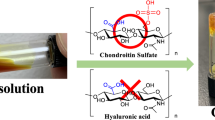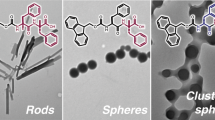Abstract
Amphiphilic ureas with hydrophilic lactose groups form transparent supramolecular hydrogels. Their gelation abilities are sensitive to the length of the alkyl chain. Amphiphilic ureas bearing hexyl, heptyl, octyl, and nonyl groups form supramolecular hydrogels, but amphiphilic ureas bearing decyl groups or longer alkyl groups do not show gelation ability. The gradual gel-to-sol phase transition of the supramolecular hydrogel is triggered by adding β-galactosidase (β-Gal) as a result of enzymatic hydrolysis of the lactose moiety. Supramolecular hydrogels could stably entrap cationic organic dyes, such as rhodamine 6G (Rh6G), even in water. The entrapped Rh6G could be gradually released in the presence of β-Gal, along with the gel-to-sol phase transition.
This is a preview of subscription content, access via your institution
Access options
Subscribe to this journal
Receive 12 print issues and online access
$259.00 per year
only $21.58 per issue
Buy this article
- Purchase on Springer Link
- Instant access to full article PDF
Prices may be subject to local taxes which are calculated during checkout





Similar content being viewed by others
References
Estroff LA, Hamilton AD. Water gelation by small organic molecules. Chem Rev. 2004;104:1201–18.
de Loos M, Feringa BL, van Esch JH. Design and application of self-assembled low molecular weight hydrogels. Eur J Org Chem. 2005;2005:3615–31.
Mukai M, Kogiso M, Aoyagi M, Asakawa M, Shimizu T, Minamikawa H. Supramolecular nanofiber formation from commercially available arginine and a bola-type diacetylenic diacid via hydrogelation. Polym J. 2012;44:646–50.
Yu G, Yan X, Han C, Huang F. Characterization of supramolecular gels. Chem Soc Rev. 2013;42:6697–722.
Du X, Zhou J, Xu B. Supramolecular hydrogels made of basic biological building blocks. Chem Asian J. 2014;9:1446–72.
Weiss RG. The past, present, and future of molecular gels. What is the status of the field, and where is it going? J Am Chem Soc. 2014;136:7519–30.
Hanabusa K, Suzuki M. Physical gelation by low-molecular-weight compounds and development of gelators. Bull Chem Soc Jpn. 2016;89:174–82.
Friggeri A, Feringa BL, van Esch J. Entrapment and release of quinoline derivatives using a hydrogel of a low molecular weight gelator. J Control Release. 2004;97:241–8.
Jayawarna V, Ali M, Jowitt TA, Miller AF, Saiani A, Gough JE, et al. Nanostructured hydrogels for three-dimensional cell culture through self-assembly of fluorenylmethoxycarbonyl-dipeptides. Adv Mater. 2006;18:611–4.
Hirst AR, Escuder B, Miravet JF, Smith DK. High‐tech applications of self‐assembling supramolecular nanostructured gel‐phase materials: from regenerative medicine to electronic devices. Angew Chem Int Ed. 2008;47:8002–18.
Boekhoven J, Stupp SI. 25th anniversary article: supramolecular materials for regenerative medicine. Adv Mater. 2014;26:1642–59.
Du X, Zhou J, Shi J, Xu B. Supramolecular hydrogelators and hydrogels: from soft matter to molecular biomaterials. Chem Rev. 2015;115:13165–307.
Yamanaka M. Supramolecular gel electrophoresis. Polym J. 2018;50:627–35.
Komatsu H, Matsumoto S, Tamaru S, Kaneko K, Ikeda M, Hamachi I. Supramolecular hydrogel exhibiting four basic logic gate functions to fine-tune substance release. J Am Chem Soc. 2009;131:5580–5.
Yamanaka M, Haraya N, Yamamichi S. Chemical stimuli-responsive supramolecular hydrogel from amphiphilic tris-urea. Chem Asian J. 2011;6:1022–5.
Sun Z, Li Z, He Y, Shen R, Deng L, Yang M, et al. Ferrocenoyl phenylalanine: a new strategy toward supramolecular hydrogels with multistimuli responsive properties. J Am Chem Soc. 2013;135:13379–86.
Yamanaka M, Yanai K, Zama Y, Tsuchiyagaito J, Yoshida M, Ishii A, et al. Cation-tuned stimuli-responsive and optical properties of supramolecular hydrogels. Chem Asian J. 2015;10:1299–303.
Ikeda M. Stimuli-responsive supramolecular systems guided by chemical reactions. Polym J. 2019;51:371–80.
Yang Z, Liang G, Wang L, Xu B. Using a kinase/phosphatase switch to regulate a supramolecular hydrogel and forming the supramolecular hydrogel in vivo. J Am Chem Soc. 2006;128:3038–43.
Vemula KP, Li J, John G. Enzyme catalysis: tool to make and break amygdalin hydrogelators from renewable resources: a delivery model for hydrophobic drug. J Am Chem Soc. 2006;128:8932–8.
Das AK, Colins R, Ulijn RV. Exploiting enzymatic (reversed) hydrolysis in directed self-assembly of peptide nanostructures. Small. 2008;4:279–87.
Ikeda M, Tanida T, Yoshii T, Hamachi I. Rational molecular design of stimuli-responsive supramolecular hydrogels based on dipeptides. Adv Mater. 2011;23:2819–22.
Tanaka A, Fukuoka Y, Morimoto Y, Honjo T, Koda D, Goto M, et al. Cancer cell death induced by the intracellular self-assembly of an enzyme-responsive supramolecular gelator. J Am Chem Soc. 2015;137:770–5.
Dong L, Miao Q, Hai Z, Yuan Y, Liang G. Enzymatic hydrogelation-induced fluorescence turn-off for sensing alkaline phosphatase. Anal Chem. 2015;87:6475–8.
Fores JR, Criado-Gonzalez M, Schmutz M, Blanck C, Schaaf P, Boulmedais F, et al. Protein-induced low molecular weight hydrogelator self-assembly through a self-sustaining process. Chem Sci. 2019;10:4761–6.
Akama S, Maki T, Yamanaka M. Enzymatic hydrolysis-induced degradation of a lactose-coupled supramolecular hydrogel. Chem Commun. 2018;54:8814–7.
Bridiau N, Benmansour M, Legoy MD, Maugard T. One-pot stereoselective synthesis of β-N-aryl-glycosides by N-glycosylation of aromatic amines: application to the synthesis of tumor-associated carbohydrate antigen building blocks. Tetrahedron. 2007;63:4178–83.
Bartesaghi A, Merk A, Banerjee S, Matthies D, Wu X, Milne JLS, et al. 2.2 Å resolution cryo-EM structure of β-galactosidase in complex with a cell-permeant inhibitor. Science. 2015;348:1147–51.
Holmes R. The intestinal brush border. Gut. 1971;12:668–77.
Sharpe LA, Daily AM, Horava SD, Peppas NA. Therapeutic applications of hydrogels in oral drug delivery. Expert Opin Drug Deliv. 2014;11:901–15.
Acknowledgements
This work was supported by Grant-in-aid for the Scientific Research (Nos. 15H03826 and 17H06374) the Japan Society for the Promotion of Science (JSPS) or the Ministry of Education, Culture, Sports, Science and Technology (MEXT).
Author information
Authors and Affiliations
Corresponding author
Ethics declarations
Conflict of interest
The authors declare that they have no conflict of interest.
Additional information
Publisher’s note Springer Nature remains neutral with regard to jurisdictional claims in published maps and institutional affiliations.
Rights and permissions
About this article
Cite this article
Maki, T., Yoshisaki, R., Akama, S. et al. Enzyme responsive properties of amphiphilic urea supramolecular hydrogels. Polym J 52, 931–938 (2020). https://doi.org/10.1038/s41428-020-0333-x
Received:
Revised:
Accepted:
Published:
Issue Date:
DOI: https://doi.org/10.1038/s41428-020-0333-x



